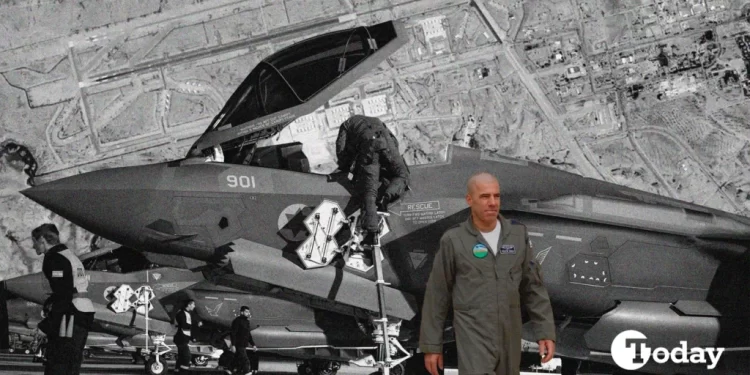These lines were written on CNN, the voice of the Democratic Party close to the US neocons, at a time when US President Biden announced that he had not yet received a guarantee that Israel would not target nuclear facilities in a possible counter-attack on Iran. This is clearly an expression of the US being held hostage by Netanyahu.
In this case, we can say that the world is under Israel’s mortgage until the US presidential elections on November 5, 2024. If Iran’s nuclear facilities are hit, it goes without saying that this crisis will grow very large and humanity will face multi-dimensional crises. It is possible to say that this situation will bring about the collapse of the US faster than the collapse of the Roman Empire.
Iran’s Attack on Selected Targets on October 1
After Iran’s attack on Israel with around 300 missiles and drones on April 14, 2024, the second attack with 180 ballistic missiles on October 1, 2024 revealed the serious vulnerabilities of Israel’s air defense system again. The strategic Nevatim and Hatzerim air bases were hit in this attack.
Today, Israel has a progressive air defense system supported by the US. The Iron Dome Low Altitude Air Defense System; the David’s Sling Medium/High-Altitude Ballistic Missile Defense System and the Arrow 2/3 High Altitude Ballistic Missile Defense System operate in conjunction with the central command and control system (IMDO). This system is also supported by the American Patriot and THAAD systems and the high precision and range X-band radars located in the Necef Desert, Keren and Kürecik Malatya.

US Navy and Israeli Air Defense
The Pentagon announced that 81 UAVs and 6 ballistic missiles were shot down by American air defense efforts in the April 14 attack. Following the October 1 attack, the Pentagon announced that a dozen of the 180 missiles were shot down by two of the three American destroyers in the Mediterranean (USS Bulkeley and USS Cole).
Four of these ships, which have the Arleigh Burke class SM 3 high altitude ballistic missile defense system, are permanently stationed at the US naval base in Cadiz/Rota, Spain. These ships are dynamically assigned and deployed to the crisis region when the ballistic missile threat to US allies and friends increases. When necessary, the ships in question, which serve in the Eastern Mediterranean, receive detection and tracking information for exo-atmospheric prevention from the American X-Band radars located in Malatya/Kürecik and Keren in the Necef Desert.
One of the main information inputs and cross-tell stations of the Aegis command and control system of the ships in question, which are connected to the NATO Ballistic Missile Defense System, in Europe and the Mediterranean basin is the “Kürecik Radar” in Malatya. This radar was brought to our country through the NATO Agreement. However, it is completely American property and Turkiye has no discretion regarding its operation. They work online with the American Aegis destroyers serving in the Eastern Mediterranean.
With this information, it is possible to shoot down Iranian missiles aimed at Israel at an early stage. Therefore, on the one hand, saying that “Israel’s target is Turkey” and on the other hand, transmitting information to American warships protecting Israel via the Americans’ X Band radar in Kürecik is a very contradictory, even oxymoronic situation.
Decrease in American Naval Support to Israel
In the October 1 attack, we see that the US provided support to Israel with roughly 50% fewer ships compared to the April 14 attack. Most importantly, there was no American aircraft carrier strike group in the Mediterranean when the October 1 attacks took place. The USS Truman aircraft carrier strike group only entered the Mediterranean from Gibraltar on the morning of October 3, 2024. This group also includes an Aegis-class cruiser and 2 Arleigh Burke-class destroyers that can support Israeli air defense.
On the other hand, the USS Abraham Lincoln aircraft carrier strike group, which was supposed to be in the Pacific theater of operations and was dispatched to the region for Israel, was in the Arabian Sea during the October 1 attack. Keeping this group at the entrance to the Persian Gulf for the purpose of deterring Iran rather than preventing air attacks against Israel is a preference of American decision-makers.
However, what is striking is the small number of American ships sent to support the defense of Israel. It was expected that Iran would attack Israel after the assassination of Hamas leader Haniyeh. The assassination of Lebanese Shiite leader Nasrallah last week increased this possibility. However, there has been no change in the number of American warships. The arrival of the USS Truman aircraft carrier coup group in the Eastern Mediterranean will only occur as these lines are being read on 6th October, five days after the October 1 attacks.
Let us remind that the record number of ships in terms of military support and assistance to Israel was set in the 1973 Yom Kippur War. The US had a presence in the Eastern Mediterranean with 60 ships during the 1973 Arab-Israeli War.

American Sea Power Is in Weakness
The fact that the US had only three Aegis class (Arleigh Burke) destroyers with air defense capability in the Eastern Mediterranean during the October 1 Iranian attack is not a strategic choice but rather a weakness in its navy. As of September 30, the day before the October 1 attack, the US Navy’s combat force was 297 ships, (237 combat ships and 60 auxiliary ships).
Of these ships, 76 combat ships and 30 auxiliary ships (106 ships in total) were deployed. However, 71 of these 106 ships were underway. US sources do not specify how many of these ships were combatants and how many were auxiliary ships.
If we assume, as a rough estimate, that 55 ships were combat ships and 16 were auxiliary ships, we understand why there were only 3 Aegis-class destroyers in the Mediterranean when the October 1 attack took place.
The fact that 106 ships out of a total of 295 were deployed is an indication of how low the ships’ combat readiness was. In addition to the fact that it will take years to raise the combat readiness of the remaining ships, let us remember that the warships held in the American reserve fleets to be used in mobilization are on average over 40 years old and in poor condition.
Damage Control Project of the Commander of the United States Naval Forces

At the end of her one-year term as force commander, US Navy Commander Admiral Lisa Franchetti prepared a road map (navigation plan) titled NAVPLAN 24 in September 2024. This report summarizes the difficult period that the US naval force is in, by its highest-level executive. Franchetti, the 33rd Chief of Naval Forces (CNO), has the following action plan in his sailing plan, which he calls Project 33:
“We cannot create a larger conventional navy in a few years, or focus solely on numbers without the right capabilities to win the struggle for sea control… But even without these resources, we will develop our war readiness, capabilities and capacity. We must understand that the navy faces serious financial and industrial constraints.”
The most important emphasis in the report is that they are preparing to fight China in 2027. This issue is included in the Sailing Plan as follows:
“The President of the People’s Republic of China has ordered his forces to be ready for war by 2027. We will be more ready.’’
Franchetti, who said that they would be more ready with an extremely childish expression, later added:
‘’The defense industry of the People’s Republic of China is currently in a war footing with the largest shipbuilding infrastructure in the world, which is currently under the command of the navy.’’
However, the fact that the US Naval Forces Commander focused on President Xi Jinping’s discourse in such an important document is a serious example of weakness. A naval power that claims to dominate the oceans and seas since 1945 accepts its rival taking the initiative to choose the time of war.
Then let’s ask, for example, what will happen if the US-Iran war starts and China decides to go to war before 2027?
The Problem of Increasing the Level of War Readiness
Another striking issue in the document is that the target is to increase the current force to 80% combat readiness. This means if 106 of the 297 ships currently available are deployed, the combat readiness level is around 35%. If we accept that some of the ships in the port at their home bases will be made ready for combat in a short time, we can accept that the readiness level will be around 50% with the highest optimism.
Admiral Franchetti aims to increase this level to 80% in the next three years. We are really faced with a picture that is very contrary to the history of the US Navy. As it is understood from both the document and Franchetti’s statements, the real problem is the maintenance and repair problem of the ships.
Warships at the end of deployments and tasking cycle they go through maintenance/ overhaul period and upon completion the combat training cycle starts before the ship totally becomes combat ready. This process, which would take 12-15 months if everything worked normally, no longer works in the US.
According to Franchetti’s statement in the navigation plan, the maintenance of surface fleets (cruisers, destroyers, amphibious ships and corvettes) is currently about 2,700 days behind, or almost seven years. This is an incredible delay.
The Role Model of the US Navy: Ukraine and the Houthis
The document very interestingly refers to the asymmetric naval successes of the fleetless Ukraine and the bare foot Houthi fighters in the Black and Red Seas, implying that the weakness of the navy will be offset by unmanned vehicles and robotic systems.
In order to prepare for a conflict with China in the Pacific in 2027, the report emphasizes a new class of unmanned systems to create low-cost, lethal air and surface systems that would disrupt an invasion beyond Taiwan. However, he does not mention that the US is an ocean state and that they will need large-tonnage platforms that can navigate the ocean to move from the CONUS to areas of interest. For example, the foundation of American naval power depends on bases and the support of these bases in wartime. Only in this way can warships in distant areas receive fuel, ammunition and personnel support. This support also needs to be created in the homeland.
However, how that logistical support will be provided from the homeland to these bases? The American merchant fleet is insufficient. They have only 200 ships flying their own flag. The US auxiliary ship fleet, MSC (Military Sealift Command), also has very limited resources. They have 19 offshore logistics support and fuel supply tankers; 14 ammunition transporters; 15 military supply transporters; 21 pre-positioned stockpiling supply ships in overseas bases and around 60 foreign-flagged leased ships. Last month, 17 of these were put into reserve status due to lack of personnel. Half of the rest are not ready for action anyway. This fleet is not even sufficient for their own needs, let alone their allies.
It is clear that these numbers will be extremely insufficient in a two-front war with China and Russia on the Atlantic/European and Asia/Pacific fronts. The combat vehicles of just one mechanized division weigh over 100 thousand tons. According to NATO’s cold war plans, the amount of cargo that needed to be reinforced from the US for supplementary supplies in the first months of a war in Europe was around 25 million tons. The military operation requirement was 100 million barrels of petroleum products.
Now let’s add the Pacific theater of operations to this picture, where the distances are much longer. We are faced with a terribly difficult picture. Because the most important US allies in the Pacific, such as Japan, Australia and South Korea, do not have oil. At least they are dependent on the US for fuel.
Let’s add the war that will continue with Russia in Europe to this situation. I am not even mentioning the sea lift that will last for months in the Pacific and the Atlantic, and therefore the need to protect these convoys against a three-dimensional threat. Except for 11 nuclear aircraft carriers, every ship needs to refuel at sea several times during ocean crossings. However, they do not have enough ships. MSC ships also do not have surface or air defense systems to defend themselves. Under these conditions, it is not clear how the Pacific front will be supported if war breaks out with China tomorrow.
American Sea Power Is Chronically Insufficient
In June 2023, the American Congress approved the naval target of 381 ships. In addition, it is aimed to have 397 ships by 2053. However, today, in order to complete the 381 ship target by 2030, a 20% budget increase is needed, which is not possible under today’s debt stock burden.
Today, the backbone of American naval power is nuclear-powered attack submarines (SSN), other than nuclear aircraft carriers and ballistic missile submarines (SSBN).
However, today, nearly 40% of submarines are under repair and the delays in repair are enormous. If aircraft carriers operate in waters close to the continent – for example, in the South or East China Sea – they are likely to be hit by hypersonic and ballistic missiles. In short, the US is unprepared for a major power conflict which is developing.
If a conflict with China were to break out tomorrow, the American Navy would have very little chance of winning because it is not ready. The logistical difficulties of building and sustaining American naval power in the short and medium terms are incredible. If the problem of replenishing existing weapons and ammunition stocks is added to this, the seriousness of the situation becomes apparent.

According to former American Undersecretary of the Navy Seth Cropsey, if the US does not increase the production of the weapons it will need in the Indo-Pacific, especially hypersonic cruise and ballistic missiles and short-range anti-ship weapons, it will lose a war for Taiwan in weeks. In its current state, the US Navy cannot maintain its bases and allies in the Indo-Pacific Oceans and its transoceanic logistical support line.
The parameters of the US-USA balance in the Cold War and today’s US-China balance are extremely different. The USSR could not defeat the US because the American Navy’s enormous size of 600 ships confined the Soviets to the continent and weakened them.
China, on the other hand, is far more advanced at sea than the US naval power today. China has the advantage in terms of both its geographical location, naval power and number of anti-ship missiles. The conditions are more in its favor than ever to bring this to a dynamic conclusion.
The US is weakening its power in the Mediterranean and the Persian Gulf because of Israel. China, on the other hand, will use every opportunity to protect and develop its own geopolitical interests, especially in Taiwan and the South China Sea, as long as the Israel-Iran crisis continues.



































